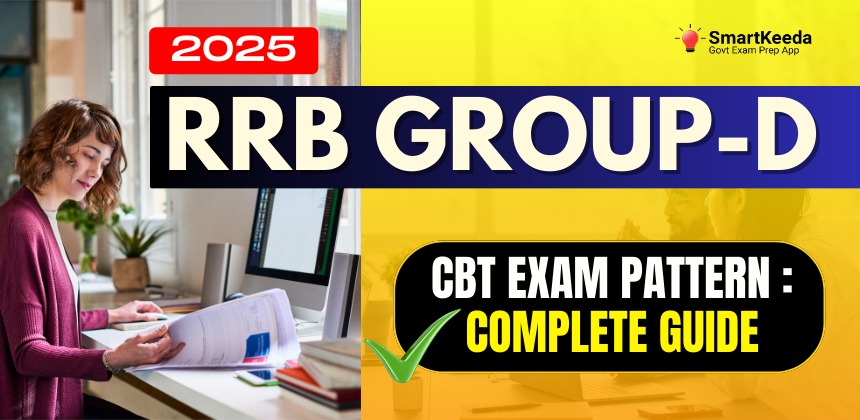RRB Group D 2025 CBT Exam Pattern – Complete Guide

32,438 vacancies for the Level 1 post of RRB Group D 2025 have been announced for the recruitment of Pointsman, Assistant, Track Maintainer, Assistant Loco Shed, Assistant Operations, Assistant Operations, and Assistant TL & AC. The exam is tentatively scheduled to take place in July or August. As the exam is nearing, aspirants should gear up and start their preparation. In this guide, we will learn about the RRB Group D 2025 Exam Pattern in detail.
RRB Group D 2025 Selection Procedure: Step-by-Step Overview
The recruitment process for Group D posts involves the following stages:
- Computer-Based Test (CBT): This is a test to check proficiency in Maths, General Intelligence, Reasoning, and General Awareness.
- Physical Efficiency Test (PET): This is the next stage, where your physical capability is checked through various activities like running and jumping.
- Medical Examination: After PET, candidates undergo a medical check-up to prove that they are physically fit according to the fitness standards of the Railway Recruitment Board
- Document Verification: All submitted documents will be verified to validate the details provided during the application process.
CBT-1 Exam Structure for RRB Group D 2025
The exam pattern can vary as RRB can conduct CBT in either or multi-stage mode. After clearing the CBT round, candidates undergo a Physical Efficiency Test (PET), which is then followed by Medical Examination and Document Verification processes.
The exam pattern for the CBT stage is given below:
|
RRB Group D CBT-1 Exam Pattern 2025 |
|||
|
Subjects |
No. of Questions |
Marks |
Duration |
|
General Science |
25 |
25 |
90 minutes
|
|
Mathematics |
25 |
25 |
|
|
General Intelligence & Reasoning |
30 |
30 |
|
|
General Awareness and Current Affairs |
20 |
20 |
|
|
Total |
100 |
100 |
|
Note:
- PwBD who are writing the exam with the help of a scribe will be allotted 120 minutes to complete their exam
- The section-wise distribution provided above may vary in the actual exam.
- There is a relaxation of 2% for the PwBD candidates, in case there is a shortage of candidates to fill the reserved vacancies
- Conducting a second CBT is at the discretion of the Railway Administration. In that case, the first stage may be treated as qualifying in nature and will be used to shortlist the deserving candidates for the next round
Physical Efficiency Tests (PET)
The Physical Efficiency Test is a test that checks the medical fitness of the candidate, according to the RRB Group D Medical Standards, which are decided by the Railway Recruitment Board. It is qualifying in nature, but it does not contribute to the final merit list.
Candidates are advised to take precautions during this round in order to avoid physical injuries to themselves or other participants, as the Railway Recruitment Board will not take responsibility for any accidents during the process.
Here is the complete breakdown of all the tests that the RRB Group D PET exam entails:
|
Candidates |
Parameters |
|
Male
|
Candidates should be able to lift and carry a 35 kg weight at a time for a distance of 100 meters in 2 minutes without dropping the weight. Must be able to run a distance of 1000 meters in 4 minutes 15 seconds at a time |
|
Female
|
Must be able to lift a 20 kg weight and carry it to a distance of 100 meters in 2 minutes without dropping the weight. Able to run a distance of 1000 meters in 5 minutes and 40 seconds in one go. |
|
PwBD
|
Persons with disabilities are exempted from appearing in the PET. After qualifying for the CBT, such candidates will have to pass the medical examination prescribed for persons with disabilities. |
- Subject-wise Syllabus Highlights
The RRB Group D 2025 Syllabus is released with the official notification of RRB Group D recruitment, which mentions the subjects and topics that will be covered in the RRB Group D 2025 Exam. The syllabus highlights for the RRB Group D post is given below.
|
RRB Group D Syllabus 2025 |
|
|
Subject |
Topics |
|
Mathematics |
Number system, BODMAS, Decimals, Fractions, LCM, HCF, Ratio and Proportion, Percentages, Mensuration, Time and Work, Time and Distance, Simple and Compound Interest, Profit and Loss, Algebra, Geometry and Trigonometry, Elementary Statistics, Square root, Age Calculations, Calendar & Clock, Pipes & Cistern etc. |
|
General Intelligence and reasoning |
Analogies, Alphabetical and Number Series, Coding and Decoding, Mathematical operations, Relationships, Syllogism, Jumbling, Venn Diagram, Data Interpretation and Sufficiency, Conclusions and Decision making, Similarities and Differences, Analytical Reasoning, Classification, Directions, Statement – Arguments and Assumptions etc. |
|
General Science |
Physics, Chemistry and Life Sciences of 10th standard level (CBSE). |
|
Current Affairs |
General Awareness and Current Affairs in Science & Technology, Sports, Culture, Personalities, Economics, Politics and any other subject of importance. |
Negative Marking and Scoring Pattern
The Marking Scheme and negative marking is decided by the Railway Recruitment Board. Candidates appearing for the RRB Group D should understand the distribution of marks and the negative marking in the exam. Given below is the detailed scoring pattern with the negative marking scheme:
- Total Marks: 100 marks for the Computer-Based Test
- Number of Questions: There are 100 multiple-choice questions (MCQs) in the exam, with each question carrying one mark.
- Negative Marking: There is a penalty of 1/3rd of a mark for every wrong answer.
- Subject-Wise Weightage:
- General Awareness and Current Affairs: 20 questions
- General Science: 25 questions
- Mathematics: 25 questions
- General Intelligence and Reasoning: 30 questions
- Unattempted Questions: There is no penalty for questions that are not attempted
Document Verification
Candidates appearing for the document verification stage of RRB Group D 2025 must carry the following documents in original, along with photocopies:
|
Document Category |
Specific Document Name |
Description / Details |
Applicability |
|
Academic & Professional
|
Educational Qualification Certificates |
Mark sheets and certificates for all academic qualifications, including ITI or its equivalent (if applicable). |
Mandatory |
|
NCVT/SCVT Certificate |
Relevant certificates and mark sheets for candidates claiming qualification through NCVT or SCVT. |
If applicable (for NCVT/SCVT qualification) |
|
|
Identity & Personal Details
|
Proof of Date of Birth |
Matriculation/High School certificate or a valid birth certificate. |
Mandatory |
|
Photo Identity Proof |
A valid government-issued ID such as Aadhaar Card, PAN Card, Voter ID, etc. |
Mandatory |
|
|
Photographs and Signature |
Passport-size photographs (matching the ones uploaded in the application form) and a clear signature. |
Mandatory |
|
|
Name Change Proof |
Gazette notification or other official documents if you’ve legally changed your name. |
If applicable (for name change) |
|
|
Category & Disability
|
Category Certificate |
Valid caste or community certificate for SC/ST/OBC/EWS candidates issued by a competent authority. |
If applicable (for SC/ST/OBC/EWS) |
|
Disability Certificate |
Valid PWD certificate for Persons with Disabilities (PWD). |
If applicable (for PWD) |
|
|
Application & Employment Related
|
Admit Card |
The RRB Group D admit card that the candidate received before appearing for the CBT. |
Mandatory |
|
NOC (No Objection Certificate) |
Required if the candidate is working in any Central/State Government department or PSU. |
If applicable (for serving employees) |
|
|
Bank Account Details |
Bank account details may be asked for the processing of salary. |
Required (for salary processing) |
|
|
Medical & Other |
Medical Certificate |
Submit a valid medical certificate if specified. |
If applicable (if specified) |
|
|
Additional Relevant Documents |
Any other certificates mentioned in the RRB Group D notification. |
If applicable (as per notification) |
Empanelment of Candidates
- Candidates have to qualify both CBT and PET in order to be on the merit list. The candidates who rank high will be called for the Document Verification (DV) in a ratio of twice the number of vacancies available, depending on the merit and preferences.
- The number of candidates beyond the number of vacancies are additional candidates and will be considered for the empanelment only if
- There is a shortfall in the final selection
- If some candidates do not join
- There are any special recruitment needs
- In case there are two or more candidates with the same scores, the tie will be broken based on:
- Age: The older candidate will be placed higher in the merit list
- In case the age is also the same, alphabetical order of names (A to Z) will be considered.
- The final selection will depend upon
- Qualifying the Medical Fitness Test conducted by the Railways Administration
- Verification of educational qualifications and caste/community certificates
- Character and background checks
Note: After being shortlisted for the Document Verification round, the candidates will be required to undergo a medical examination. However, clearing the medical exam doesn’t guarantee the job if the candidate falls outside the notified vacancies.
Final Merit List Preparation
- Basis of selection:
The final merit list for the selection of RRB Group D is made on the basis of the marks secured by the applicants in the Computer Based Test. However, to make it to the final merit list, the candidate also needs to successfully qualify the next stages, namely PET, DV and Medical Examination
- Cut-off criteria:
To make it to the final merit list, the candidate has to score above the cut-off marks for the category (General, SC, ST, OBC, EWS) and the regional zone they belong to. These cut-off marks are the minimum qualifying marks and are different for all the categories and regional zones
Minimum Qualifying Marks for CBT-1 and PET
The minimum qualifying marks for different categories are as follows:
- UR/EWS: 40%
- OBC (Non-Creamy Layer): 30%
- SC/ST: 30%
There are no specific minimum qualifying marks for the RRB Group D Physical Efficiency Test as there is for the CBT.
Candidates are only required to meet the physical standards (mentioned in the previous sections) to be eligible for the job.
Meeting those physical standards is a pass or fail situation and doesn’t have a percentage-based score





